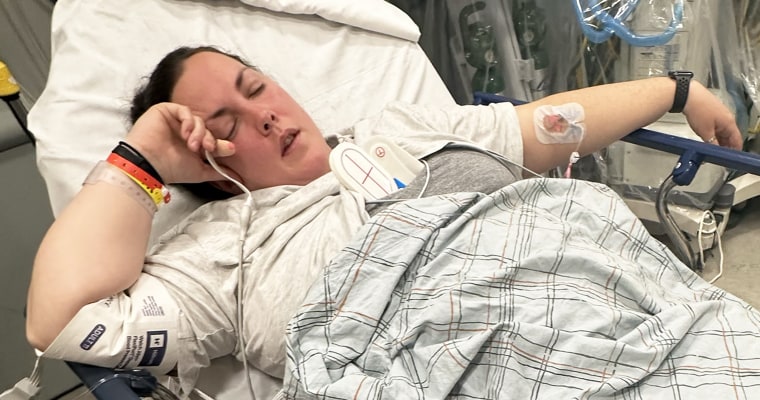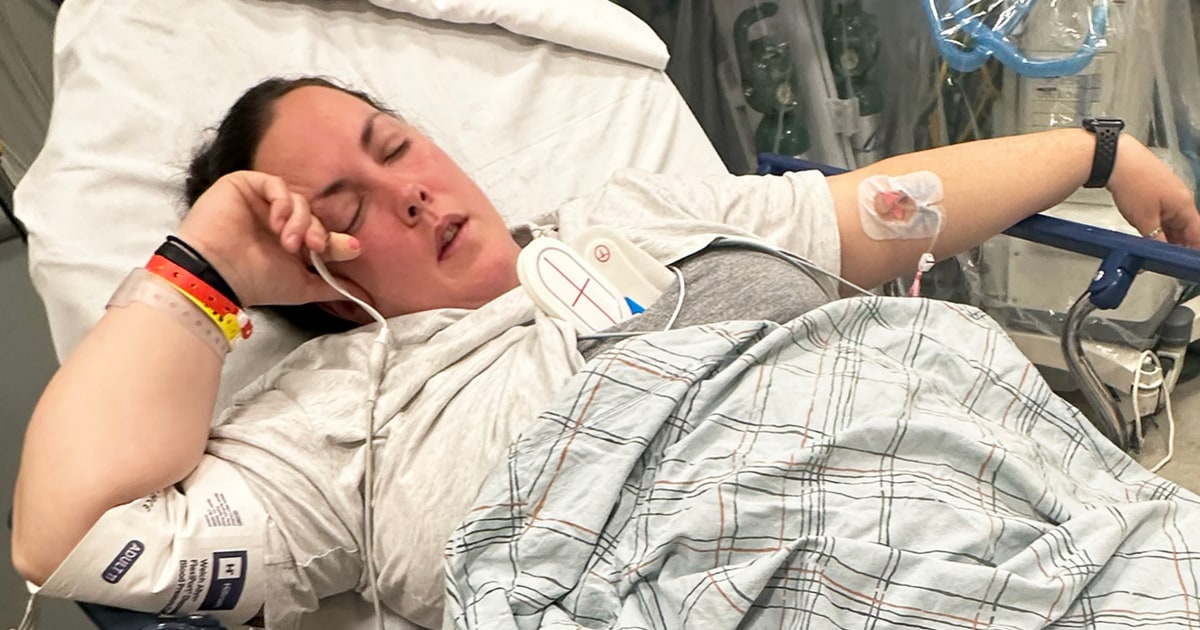In May 2023, after taking care of a friend's dog, Jessie Malone, then 35 years old, woke up feeling nauseous. She didn't think much of it and she went home on an electric bike. As she approached her apartment, the alarm on her Apple Watch started ringing.
“He said he had to seek immediate medical attention,” Malone, 36, who lives in New York, told Today. “She was red (the alert) and vibrated. I said, 'Oh my God.'”
He decided to go to the emergency room, where he learned he was suffering from atrial fibrillation (Afib), a fast, irregular heart rhythm that can cause blood clots and stroke, according to the American Heart Association.

“If my watch hadn't told me anything, I would have gone home and taken a nap,” Malone said.
Atrial fibrillation may be more common and more serious in young people than previously thought, according to new research. And, like Malone, it seems that more and more young people are receiving the diagnosis thanks to the Apple Watch, experts say.
“Has anyone in your family died without explanation?”
When Malone woke up in her friend's apartment and felt nauseous, she waited an hour before returning home. She felt well enough to ride the bike, but during the ride she noticed that her heart rate increased to 160 beats per minute.
According to the American Heart Association, a normal resting heart rate is 60 to 100 beats per minute.
“I felt nothing but nausea,” he explained. “That gave me a little anxiety. I said to myself: 'how strange.'”
But he only became worried when his watch started sending him alerts about a medical emergency.
“He started telling me that my resting heart rate was high and also that I had gone into atrial fibrillation,” Malone recalled.
Although the woman was not familiar with atrial fibrillation, which usually affects older people, she decided to go to the emergency room at Mount Sinai West Hospital.
“I left the bike and texted my friend who I had just dropped off and explained, 'this is happening. I don't know if it's serious,'” she recalled.
The emergency room staff began taking her vital signs while she explained what her watch said. Shortly after her arrival, hospital staff began to mobilize.
“Suddenly I was surrounded by eight doctors,” Malone said. “That's when one of them's first question was: 'Has anyone in his family ever dropped dead without explanation?'” Although Malone tried to joke about it, she quickly realized how serious it was.
Doctors informed him that to regain control of his heart, they had to give him medication that would stop it so they could restart it with a defibrillator. But that didn't work, so they found another one that reduced his heart rate to 130 beats per minute.
“Atrial fibrillation is rare at my age, so they hoped it would correct itself,” he explained. “But it was not like that”.
The doctors admitted her and planned to operate on her the next day if her heart rate remained elevated. All of this left her stunned.
“I was in shock the entire time. It seemed like an out-of-body experience,” she said. “I was very nervous”.
The next day, Malone's heart rate was still elevated, so doctors performed cardioversion, a minimally invasive procedure in which they use an endoscope to examine the heart, then send electrical currents to return it to a normal rhythm. The next day he was able to return home and stopped by the local pharmacy to buy beta blockers and anticoagulants which, he stated, he had to take for a month.
“It was one of those things that, in a normal scenario, would have made me feel frustrated,” she accepted. “But I was like, 'Wow, I'm alive and I'm in this pharmacy. This is great'”.
What is atrial fibrillation?
Atrial fibrillation is “one of the most common abnormal heart rhythms,” explained Dr. Asad Mohammad, a cardiac electrophysiologist at Mount Sinai West Hospital. People with atrial fibrillation experience abnormal contractions in the upper chambers of the heart, which stops working as it should.
“Instead of contracting in a very defined way, the upper chamber shakes and because of this phenomenon, blood flow through the upper chamber of the heart is less efficient,” Mohammad told Today. “Blood flow stagnates a lot.”
This slow blood flow in the upper chambers of the heart contributes to clot formation. If they reach the brain, they can cause a stroke.
The symptoms
Most people with atrial fibrillation show signs that something is wrong, such as:
- Feel more fatigued.
- Decreased energy levels.
- Palpitations or fluttering in the chest.
- Chest pain.
- Fainting.
But in some cases, people have no symptoms, what experts call “silent atrial fibrillation.”
“This is a more serious or fatal form of atrial fibrillation, in which many people are not even aware of the presence of symptoms and may suffer a series of events, such as a stroke or mini-stroke, and discover retrospectively that they have atrial fibrillation. ”Mohammad explained.
Atrial fibrillation in young people
Although atrial fibrillation is common in older people, it is estimated that it only affects 1% of those under 40 years of age, Mohammad added.
However, new research shows that it may be more common. A study published in the journal Circulation Arrhythmia and Electrophysiology found that more than a quarter of Afib visits between 2010 and 2019 at the UPMC Heart and Vascular Institute in Pittsburgh were among people under age 65: 17,335 out of a total of 67,221.
It also found that young people with Afib were more likely to be hospitalized for heart failure, stroke and myocardial infarction, and had higher mortality rates than people of the same age without the condition.
Among young people who suffer from it, many have a genetic predisposition or a history of valvular heart disease. But some face lifestyle risk factors that can influence the development of atrial fibrillation. Among them are:
- Sleep apnea.
- Uncontrolled arterial hypertension.
- Sleep deprivation.
- Excessive consumption of stimulants, including caffeine.
- Excessive alcohol consumption.
The study also found that many of the young people analyzed had risk factors for heart disease, especially smoking, obesity, high blood pressure and sleep apnea.
Malone had no genetic predisposition or underlying disease. But he had been sleeping little and consuming a lot of caffeine for several weeks.
“The doctor was under the impression that (lack of sleep and too much caffeine) could have accumulated and gotten to the point where it caused the atrial fibrillation,” Malone said. “It was the perfect storm of essentially living in New York and not taking proper care of myself.”
Lack of sleep causes stress hormones like epinephrine and norepinephrine to rise, while caffeine intensifies them, Mohammad explained.
“Stress hormones can have an active effect on the electrical cells of the heart and, therefore, increase their activation rate,” he added.
How is atrial fibrillation treated?
Treatment for atrial fibrillation depends on its severity, and methods to deal with it range from drugs to procedures that include sedation.
“The most common treatment option we offer to restore a patient's normal heart rhythm is called cardioversion,” to which Malone underwent, the doctor explained. “We provide the patient (who is under sedation) with a gentle electrical current through their chest, which essentially restores the normal (heart) rhythm.”
Doctors also perform an ultrasound and use a video camera to make sure there are no structural problems inside the organ. After cardioversion, patients should take blood thinners to reduce the chance of clot formation.
People with frequent atrial fibrillation may undergo a more aggressive treatment called ablation, in which doctors burn or freeze areas of the heart that contribute to the irregular heartbeat.
“The earlier the ablation is performed in the natural course of atrial fibrillation, the greater the chance of cure,” Mohammad explained.
As for Malone, the young woman said that her experience with Afib was probably “an isolated event, which should not be repeated in the future.”
“We have to change everything”
When she was hospitalized and treated for Afib, “I felt like lightning had struck me,” Malone said. “It was like: You can go back to what you were doing and this will happen again or you have to change everything.”
Malone has to be at work every day at 5:00 am as a producer, so she focused on changing everything she could, including cutting out caffeine and alcohol and changing her diet.
“I prioritize sleep a lot,” he explained. “It's above all about me recovering in a healthy way.”
Malone also started exercising. Slowly at first, like walking around the block or doing 10-minute classes on his exercise machine. About six months after her episode, her doctor cleared her to do more cardio, so she signed up for a marathon and started training. Over the last year, the changes added up and Ella Malone lost 90 pounds.
“I didn't look at the scale,” he mentioned. “The goal was to move the needle toward health and a healthy heart.”
In early May he will run a marathon in Washington, DC to commemorate the year since his hospitalization.
“I feel like a completely different person, with much more energy,” he noted. “You have to prioritize your own health: that's the most important thing.”

